Stihl Chainsaw Won’t Start
You wake up one early morning with the sole intent of getting some work done. Whether it’s chopping down some large trees for milling or bringing home some firewood for the winter, you put on your safety gear, load up your trusty Stihl and head to the forest.
But as you pull on the starter rope a couple of times, a grim realization sinks in – your chainsaw just won’t start! Well, there goes your plan for the entire day. And don’t forget about the hefty repair cost that you will soon have to bear when you take your saw to a repairman.
Believe it or not, this situation is more common than you think. And whether you have faced it yourself or seen it happen, I’ll tell you right now – you don’t need to rush to a technician. If your Stihl chainsaw is showing starting problems, there’s probably an easy fix for it.
You see, starting issues in Stihl chainsaw can occur for several reasons. Faulty spark plugs, a clogged carburetor, and a flooded engine are just some of the many things that might be preventing your chainsaw from starting up. And if you know the cause, then fixing it is simply a matter of time.
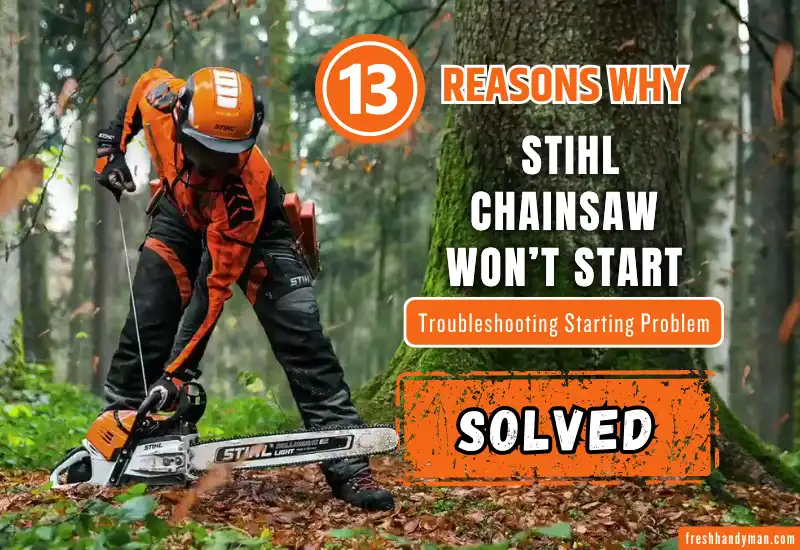
In this article, I will explore these reasons and help you start that stubborn-old Stihl chainsaw that’s refusing to start. So, let’s hop in.
What Causes a Stihl Chainsaw to Not Start or Troubleshooting?
As I said just now, the trick to fixing starting issues with your Stihl chainsaw is to figure out what’s wrong with it. And as it turns out, there can be several problems that can prevent the engine from starting up.
Here’s a quick chart to show you all the possible problems and fixes for a Stihl chainsaw that won’t start.
| Possible Causes | Troubleshooting Steps |
|---|---|
| Empty Fuel Tank or Stale Fuel | Refill or Replace the Old Fuel |
| Dirty Fuel Filter | Clean or Replace Fuel Filter |
| Clogged Air Filter | Clean or Replace Air Filter |
| Dirty or Faulty Spark Plug | Replace the Spark Plug |
| Clogged or Punctured Fuel Line | Remove the clog and patch up the leak |
| Malfunctioning Carburetor | Clean or Repair the Carburetor |
| Incorrect Oil Mix | Drain old fuel and pour fresh batch of fuel with the right ratio of oil and gas. |
| Flooded Engine | Follow the Unflooding Procedure |
| Defective Recoil Starter Assembly | Identify the Broken Parts and Replace |
| Primer Bulb Malfunction | Replace the Bulb |
| Defective Spark Arrestor | Clean the Arrestor and Replace the Mesh |
| Faulty Ignition Coil | Test the coil and replace it |
| Faulty Switch | Test the switch and replace it |
Some of the issues are easily fixable, and I will address the solutions as I talk about them in greater detail. But for some fixes, you might need to read to the end of the article. With that said, here is a complete rundown of the probable culprits that are causing your Stihl chainsaw to not start.
1. Empty Fuel Tank/ Stale Fuel
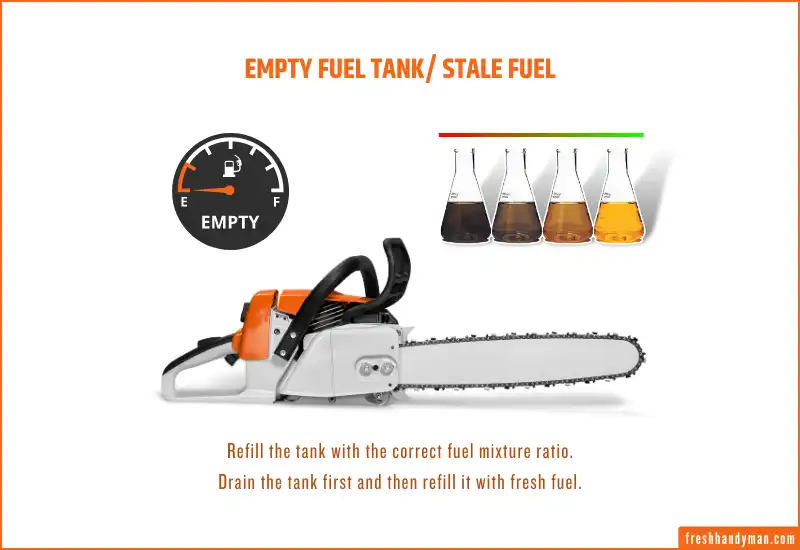
I know this is a pretty basic thing, but still – make sure your chainsaw fuel tank is topped off with fresh fuel if you are having starting issues with it. A seasoned chainsaw operator knows the importance of refilling the tank in due time, but it’s a pretty common mistake to make for a beginner.
If you don’t replace the fuel in your chainsaw regularly, it can go stale, which can cause all sorts of problems, including the engine failing to start up. So if you’re having starting issues with your chainsaw, this is where your troubleshooting should begin. Drain the fuel tank, refill it with fresh fuel and try starting it.
Quick Fix: If the fuel tank is empty, refill it with the correct fuel mixture ratio. For old fuel, you’ll need to drain the tank first and then refill it.
2. Dirty Fuel Filter
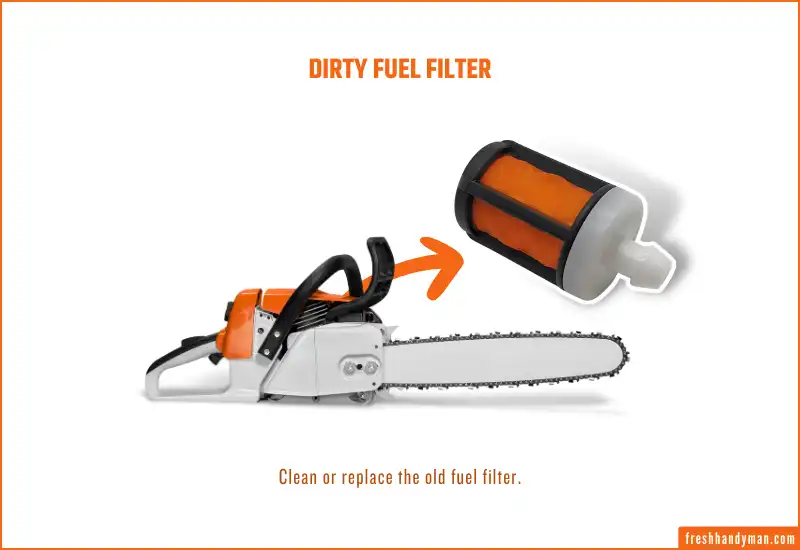
Gasoline chainsaws require a steady supply of fuel to the engine to keep working. And at the end of the fuel line rests the fuel filter keeping gunk and debris from getting to the engine. Needless to say, the fuel filter gets clogged up over time, and when that happens, the fuel flow is disrupted.
While the chances of your chainsaw not starting because of this issue are slim, it’s still a possibility if the clog is too severe. To fix this issue, simply pop off the crankcase, remove the filter, and replace/clean it as needed. Once a fresh, clean filter is installed, you should be able to fire up your chainsaw without any issues.
Quick Fix: Clean or replace the old fuel filter
3. Clogged Air Filter
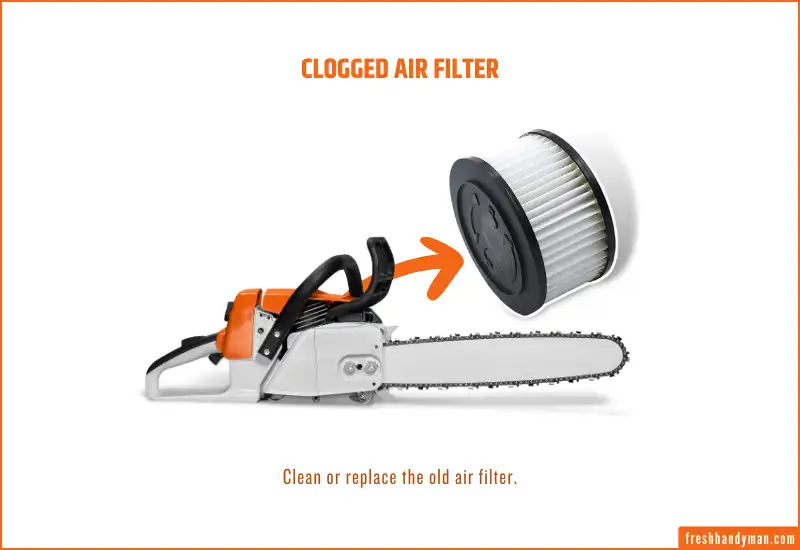
Chainsaw engines run on a delicate balance of fuel and air mixture and if the mixture goes off, all sorts of issues can start to surface. Your chainsaw refusing to start is not the only problem that can come out of it. Other issues such as rough engine performance, sudden idling can also happen because of it.
And in addition to a clogged fuel filter, blockage in the air filter can also lead to this sort of issue. Like before, to fix your air filter, all you need to do is clean or replace it. Ideally, you want to replace your air filter at least once every six months of use.
Quick Fix: Clean or replace the old air filter
4. Dirty/Faulty Spark Plug
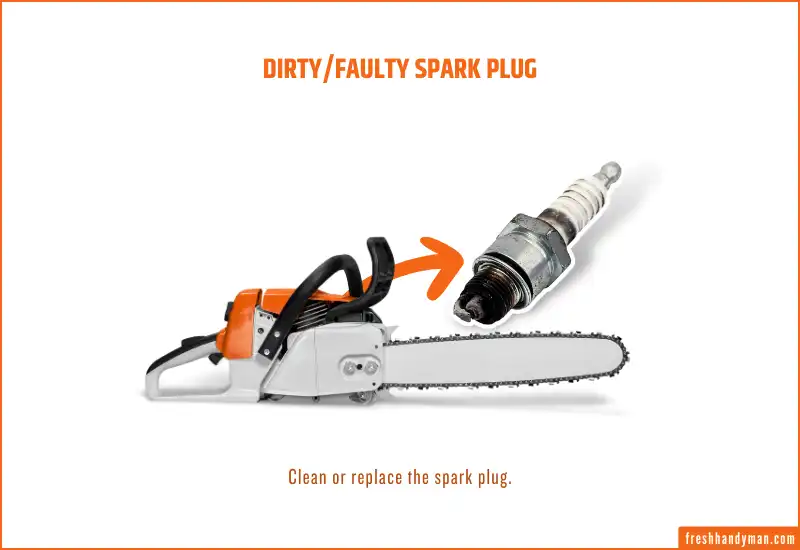
As you crank your chainsaw, the spark plug produces a spark that starts up the ignition process in the combustion engine inside it. And like any other component in the chainsaw, it can sometimes fail. When that happens, the engine can’t fire up because there’s no spark(duh!).
Even if your chainsaw’s spark plug is functional, if it’s too dirty, it won’t be able to produce the spark that’s needed for the engine to start. Gunk can build up around the spark plug case preventing your engine from starting up. In that case, cleaning it should fix the problem.
But if the spark plug is broken or damaged, then replacing it is the only option. Stihl recommends replacing their spark plug once a year as it’s natural for them to fail after a while. But those who use the chainsaw regularly might need to replace it sooner than that.
Quick Fix: Cleaning a dirty spark plug might fix the problem. But if the problem persists, you need to replace the spark plug. I will talk about the signs of spark plug damage in a later section of this article.
5. Clogged or Punctured Fuel Line
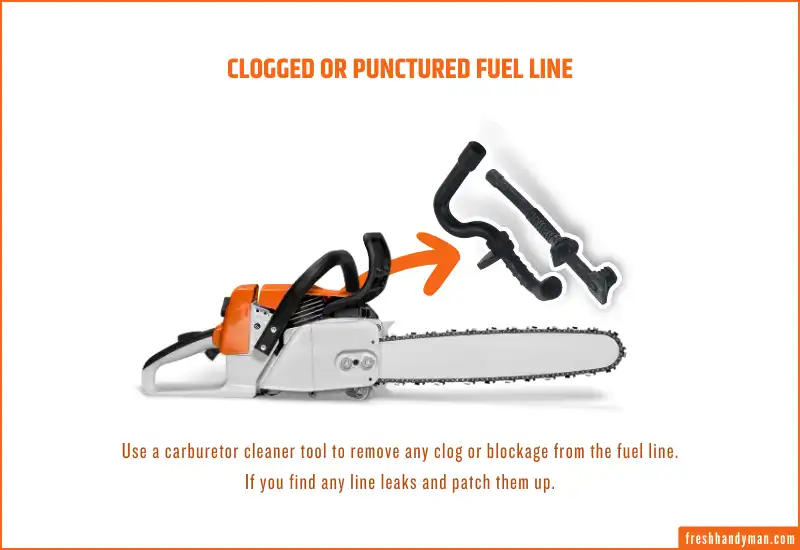
Remember when I said old fuel that goes stale in your chainsaw could become a problem and lead to starter issues in your chainsaw? Well, it goes a step further. You see, old fuel can often leave behind a residue that, when enough of it builds up, can restrict the fuel flow.
So even when you drain the tank and refill it with fresh fuel, your chainsaw won’t start as the fuel line is disrupted. In that situation, you need to remove the blockage and clean the fuel line.
There’s also a small chance that the fuel line got punctured and its leaking fuel. So you should also inspect the fuel line carefully and patch up any leaks you find in it.
Quick Fix: Remove the clog or blockage from the fuel line using a carburetor cleaner tool. Inspect for line leaks and patch them up if you find any.
6. Malfunctioning Carburetor
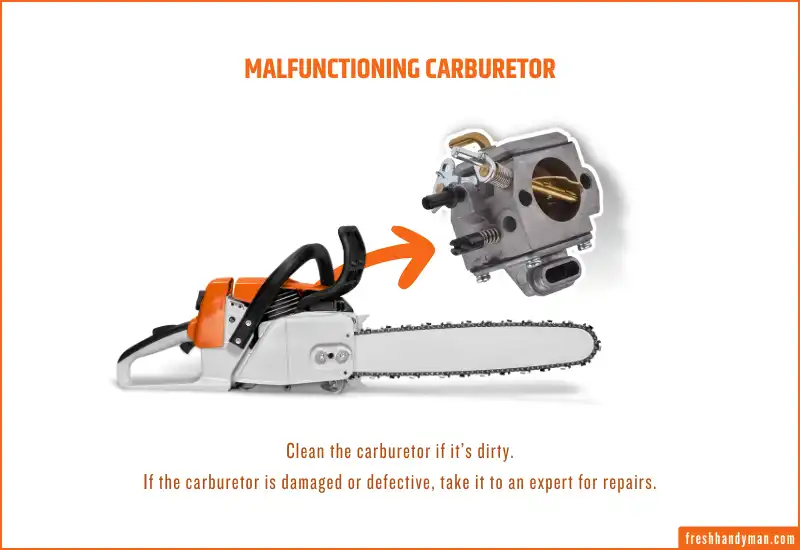
The carburetor is a vital component in a chainsaw with a very important job – to mix the right amount of air with the right amount of fuel. After mixing the right ratio of fuel-to-air mixture, the carburetor sends it to the engine. Now I know Stihl is an amazing chainsaw brand with high-end parts in their machines, but that doesn’t mean the carburetor can’t get dirty.
And when a carburetor gets clogged with dirt, sawdust etc., the fuel-to-air mixture ratio can get disrupted. This is more common in cases where the operator does not drain residual fuel from the tank and lets it go stale inside the chainsaw frequently.
Now if it’s simply a case of a dirty or clogged carburetor, cleaning it up should fix the starting issue. However, sometimes carburetors can go defective. And if you’re sure that the carburetor is the culprit and cleaning it isn’t cutting it, then you might need to replace it. In that case, it’s best to consult an expert.
Quick Fix: Clean the carburetor if it’s dirty. But if the carburetor is damaged or defective, you need to take it to an expert for repairs.
Read Also: How to Adjust a Carburetor On a Stihl Chainsaw: 4 Easy Steps
7. Incorrect Oil Mix
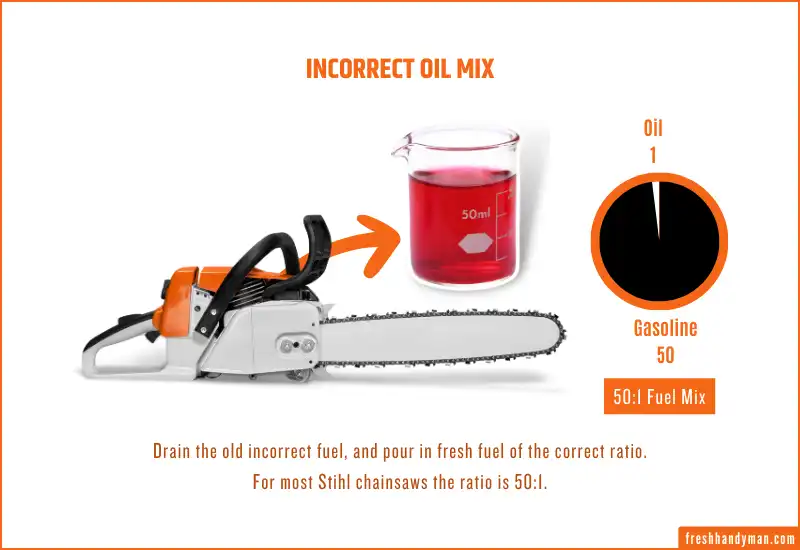
Stihl chainsaws do not run on pure gas. Even though they are called gasoline-powered chainsaws, putting straight gas can damage your chainsaw and lead to expensive repair bills as you’ll need to replace the engine. Instead, what you should use is a specific mixture of gas and oil.
You see, the engine in a Stihl chainsaw requires lubrication, and since gas is dry, it can lead to a seized engine when you put pure gas in it. You need to use premium-grade engine oil for 2-cycle engines with ethanol-free gas that’s rated for use with your chainsaw.
If you used the wrong fuel type with your chainsaw, it might explain why your chainsaw is not starting. You need to drain the tank, clean it, and pour a fresh batch with the right ratio of oil and gas.
For a beginner, this might be a bit complicated to figure out. And since each chainsaw is different, it’s hard for me to recommend a specific gas/oil mixture for your chainsaw without knowing its model. So I’ll recommend asking an expert for advice on the best fuel for your chainsaw.
If you have a chainsaw from a different brand, then the ratio would be different. For instance, the fuel mix in a Husqvarna chainsaw is not the same as what you would use in a Stihl chainsaw.
Quick Fix: Make sure you are using the correct oil to gas mixture in your chainsaw when you are filling up the fuel tank. Drain the old incorrect fuel, and pour in fresh fuel of the correct ratio. For most Stihl chainsaws the ratio is 50:1.
8. Flooded Engine
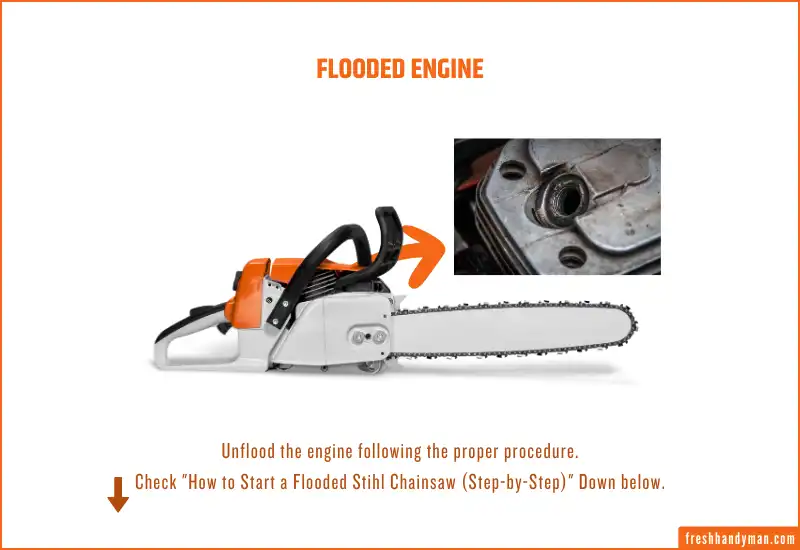
Engine getting flooded is a common problem with any combustion engine-driven machine, and a chainsaw is no exception. It’s usually caused by an error on the user end. Typically, engine flooding happens when you pull the starter rope several times when the choke is up.
This causes excessive fuel to get into the engine pushing out the oxygen. And without oxygen, combustion can’t happen, which means the engine will not be able to start.
Fixing a flooded engine in your chainsaw is pretty easy. But since it involves going through a couple of steps, I will talk about it in a later section of this article.
Quick Fix: Unflood the engine following the proper procedure. I will talk more about the steps to fixing a flooded engine in the section below.
9. Defective Recoil Starter Assembly
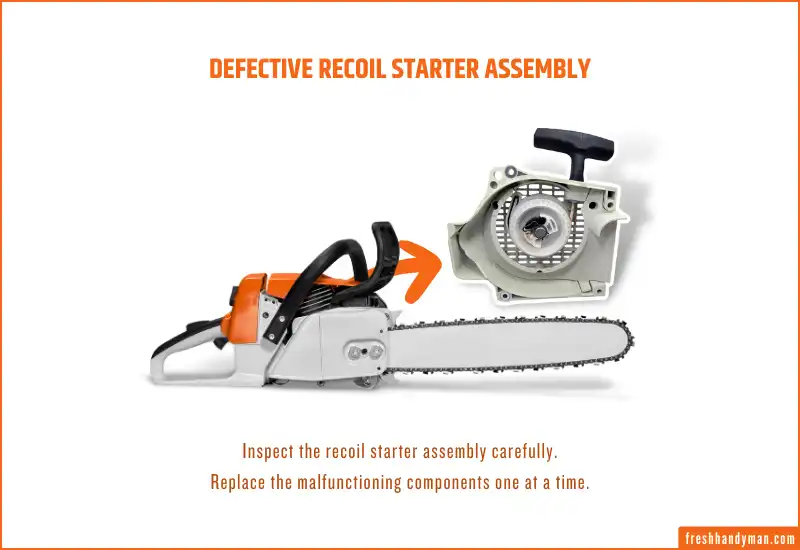
If you’re a newcomer to power tools like chainsaws, you might not know much about the recoil starter. Simply put, it’s the device that’s responsible for revving the crankshaft. And if there’s a problem with the assembly, then it’s natural for starting issues to come up in your chainsaw.
When the recoil starter assembly is working as intended, the tabs grab the engine hub when you pull on the cranking rope. This gives the engine enough torque to fire up. And when you release the rope, it rewinds back on the pulley.
Issues with the recoil starter assembly mean there’s a broken component somewhere, and you need to open up the case and search for the faulty piece. You need to check for damages or defects in the rewind spring, ground wiring, or master control lever.
Once you find the problem, all you need to do is replace the broken part, and you should be good to go.
Quick Fix: Inspect the recoil starter assembly carefully and identify the malfunctioning components. Once you find them, replace them one at a time.
10. Primer Bulb Malfunction
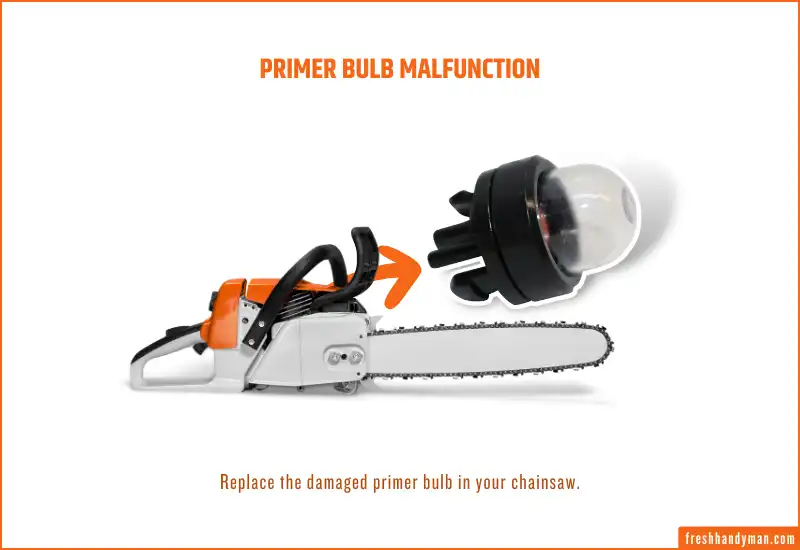
Some Stihl chainsaws come with a built-in primer bulb to make it easier for you to fire up the engine. But ironically, in some situations, the primer bulb can be the root of all the starting issues you find in your chainsaw.
You see, it’s not uncommon for the primer bulb to break or crack when you are operating the chainsaw. And a broken primer bump can’t fill up, which will, in turn, disrupt the fuel flow to the carburetor.
So, check the primer bulb for any signs of cracks or damage. If you find any, replacing it should solve the starting problem in your chainsaw.
Quick Fix: Replace the damaged primer bulb in your chainsaw.
11. Spark Arrestor Defect
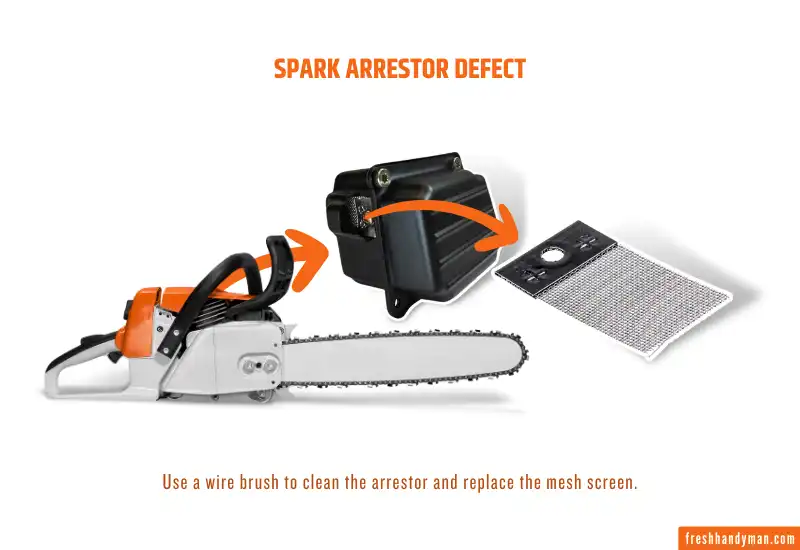
Stihl chainsaws come with a spark arrestor to eliminate the possibility of the engine catching fire due to some sort of malfunction. And sometimes, a faulty or dirty spark arrestor can get in the way of you starting your chainsaw.
You see, spark arrestors, due to their positioning, regularly come in contact with soot or gunk. And when it gets coated with debris, it can prevent airflow to the engine. This can affect the engine performance and, in extreme cases, can downright prevent the engine from starting up.
Thankfully, the fix is very easy. Take a wire brush and clean the spark arrestor thoroughly. And if the mesh screen near the spark arrestor looks damaged, replacing it should solve the problem.
Quick Fix: Use a wire brush to clean the arrestor and replace the mesh screen.
12. Faulty Ignition Coil
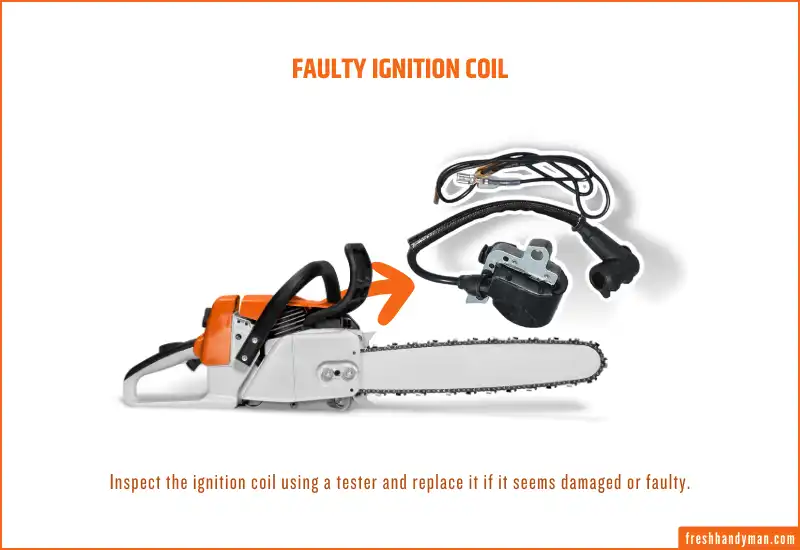
The ignition coil in a Stihl chainsaw sends the required voltage to the spark plug to produce the spark. And as you already know, the spark from the spark plug is what’s responsible for getting the engine fired up.
Now, if the ignition coil in your chainsaw is faulty or damaged, it won’t be able to send the voltage to the spark plug. And no spark means no combustion, and the engine in your chainsaw will not start up. This usually happens when there’s a short in the coil.
If you have a coil tester, you can easily check if the ignition coil is working. If not, you might need to take it to a professional for an expert diagnosis. If the ignition coil is the culprit, you need to replace it.
Quick Fix: Inspect the ignition coil using a tester and replace it if it seems damaged or faulty.
13. Wrong Setting or Faulty Switch
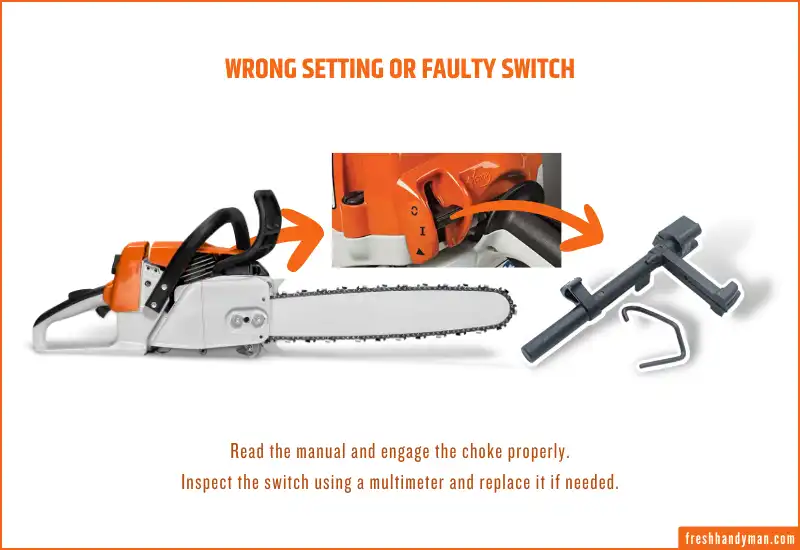
Let me share a story – My first Stihl chainsaw was an MS170 that wouldn’t start no matter what. And after going through multiple troubleshooting steps, I realized that the chainsaw was fine – I simply didn’t engage the choke properly.
Now the purpose of the story is to tell you that people make mistakes, and sometimes if your chainsaw doesn’t start, it could mean that there’s a problem on the user side of things. So, make sure you read the manual thoroughly and follow the proper steps to start your chainsaw.
Of course, if your chainsaw has a faulty switch, it won’t start even if you follow all the right steps. You can use a multimeter to check if the switch is functional. If the switch is faulty, all you need to do is replace it.
Quick Fix: Inspect the switch using a multimeter and replace it if needed.
Is there a Trick to Starting a Stihl Chainsaw?
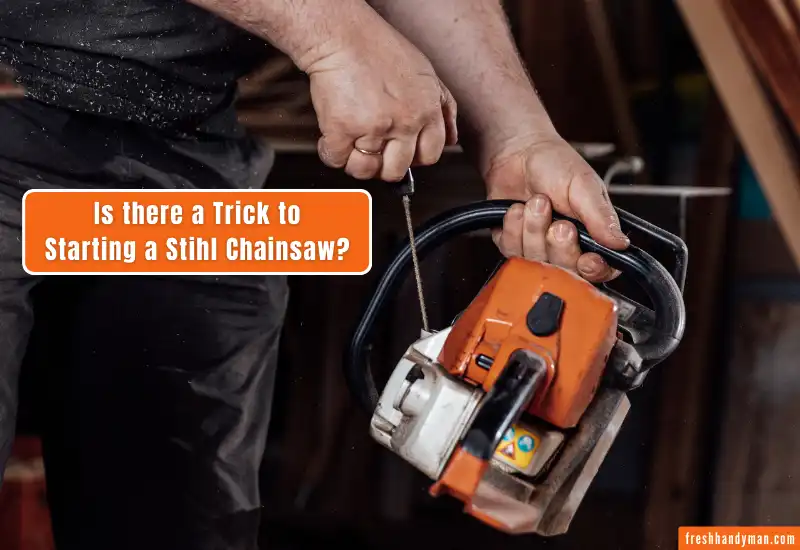
To be honest, there’s no big secret to starting a Stihl chainsaw. It works just like any other chainsaw, and the starting process of Stihl chainsaws is pretty much the same across the board. So, whether you are starting a Stihl MS250 or a Stihl 025, the process is the same.
Here’s a quick refresher on how to start a Stihl Chainsaw:
- Place your chainsaw on the ground and hold it down by placing your foot on the rear handle. Set the master control lever to the Full Choke position
- Pull on the starter rope three times and move the master control lever to the Half Choke position.
- Again, pull on the starter rope three more times, and the engine should fire up.
- Let the engine warm up for about 10 seconds, and squeeze the trigger to move the control lever to the I position.
That’s all you have to do to start a Stihl chainsaw.
Why is My Chainsaw Getting Fuel and Spark but Won’t Start?
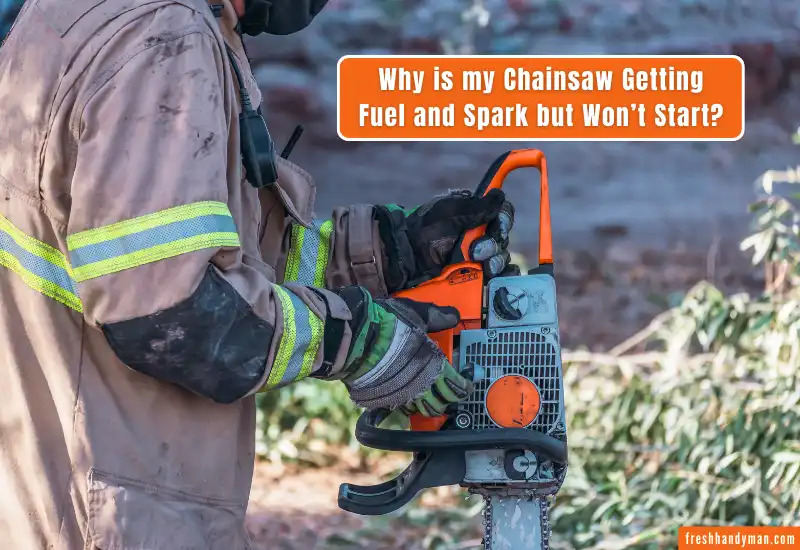
Sometimes you might notice that even though your chainsaw has a full fuel tank and functional spark plug, you can’t start it up. It’s a weird issue, no doubt about it, but there are some explanations for that.
The first possibility is that the spark plug is faulty. If the problem started when you replaced your old spark plug, then this is the most probable culprit. In that case, you need to try out a different spark plug and see if that fixes the problem.
Another reason behind this issue is dirty air or fuel filter. If the filters get dirty, it can throw off the ratio of the fuel-to-air mixture in the engine, which can lead to this sort of starting issue. Fixing it is simply a matter of taking out the old filters and cleaning or replacing them.
In most cases, these two methods should fix the problem. However, if your chainsaw still refuses to fire up after trying the fixes, consider taking it to a professional technician for repairs.
I talked about it in another article that you might want to read if you want a more in-depth explanation of this problem.
How to Start a Flooded Stihl Chainsaw (Step-by-Step)
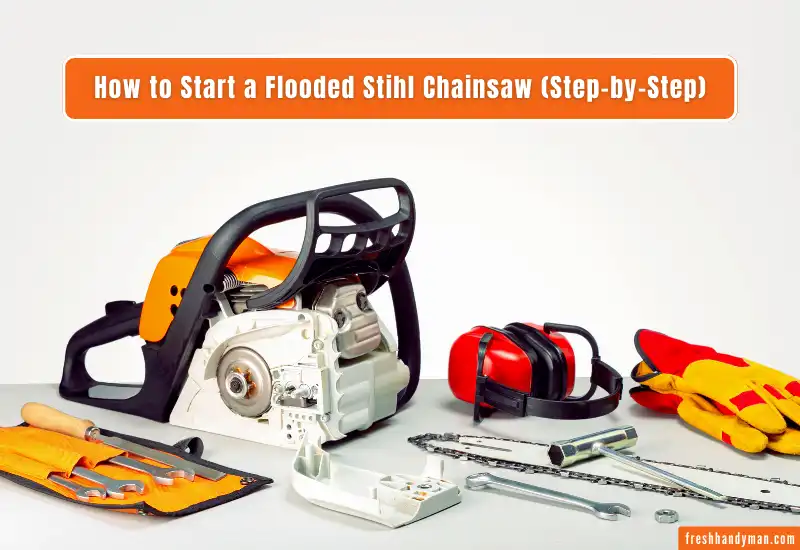
As I said earlier, a flooded engine could be a reason why your chainsaw is refusing to start. But it’s not a major cause for concern. Fixing a flooded engine is pretty easy and only involves a couple of small steps.
Step – 1
Preparation is everything. So, start by putting your chainsaw on a flat surface, preferably a table, in front of you. Pull on the brake lever to engage the chain break, and give your chainsaw a quick wipe to get rid of any dust.
Step – 2
Start disassembling the case cover. With Stihl chainsaws, there’s usually a nut at the back cover that you can unscrew. Set the master control lever to the full choke position and pull off the back cover once you unscrew the nut.
Step – 3
Remove the spark plug cover and take it out. Now is a good time to clean the spark plug or replace it if you need to. With the spark plug out, set the master control lever to the OFF position and then bring it down one notch and rest at the IDLE position.
Step – 4
Make sure your chainsaw is stable. I like to hold it near the chainsaw to make sure that it doesn’t wobble. At this point, you need to pull the start rope ten times without stopping. After that, wait 5 seconds. Then pull the rope again ten more times.
Step – 5
You should start to see flooded fuel come out through the opening of the spark plug. Wipe it off using a clean towel. If your engine is still flooded, you can repeat the process until all the fuel is out of the engine.
Step – 6
Now all that’s left to do is for you to clean your chainsaw and out all the pieces back together. You can take this moment to clean off other components like the air and the fuel filter. Once your chainsaw is assembled, you should be able to start it up normally.
How Many Pulls Should It Take to Start a Chainsaw?

Chainsaws have come a long way since its conception. Back in its early years, you would need to jump through a lot of hoops just to get it started. Even when the cranking design came out, you needed to crank the starter rope ten or twelve times just to fire up the engine.
Thankfully those days are long behind us. These days, chainsaws are much easier to start thanks to different technologies integrated into the engine and overall design of the newer models. Stihl is among the first manufacturers to add a quick start design to their chainsaws.
Most Stihl chainsaws require you to pull on the starter rope only five or six times at best to get the engine started. In most cases, your chainsaw should start only after three pulls.
So, if, for some reason, your chainsaw refuses to start after pulling on the rope six times or more, there’s a problem with your chainsaw. In that case, you need to do a thorough diagnosis and figure out the cause. And since I already gave you the possible fixes, you should be able to work out the rest by yourself.
How Do You Know If You Have a Bad Spark Plug in Your Chainsaw?
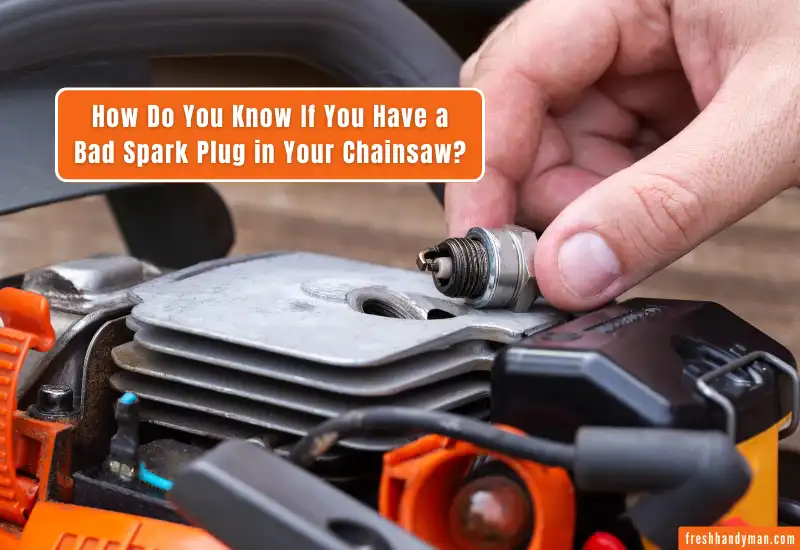
I’m sure you’ve noticed how the spark plug is a major culprit that often prevents your Stihl chainsaw from starting up. Well, whether you call it a design flaw in combustion engines or a major annoyance, the truth is you need to be prepared to replace it whenever an issue pops up.
I, for one, like to keep a personal stock of spare spark plugs for emergency situations. But being prepared alone is not enough –you also need to understand when the spark plug is faulty. The most surefire way to figure out whether you have a bad spark plug in your chainsaw is to open it up and inspect it thoroughly.
Sometimes looking at the spark plug tells you all you need to know about why your chainsaw is not starting up. A spark plug that’s coated with grime and gunk will not work properly and can prevent engine combustion.
If the spark plug is damaged, you will notice black carbon buildup around the gap between the sparking end and the metal piece that looks like a hook at the end of the casing.
You can usually tell that the spark plug is faulty before opening up your chainsaw if the engine starts running rough for no reason, even on fresh fuel. But I would always recommend opening it up to make sure.
When To Take Your Chainsaw to A Specialist
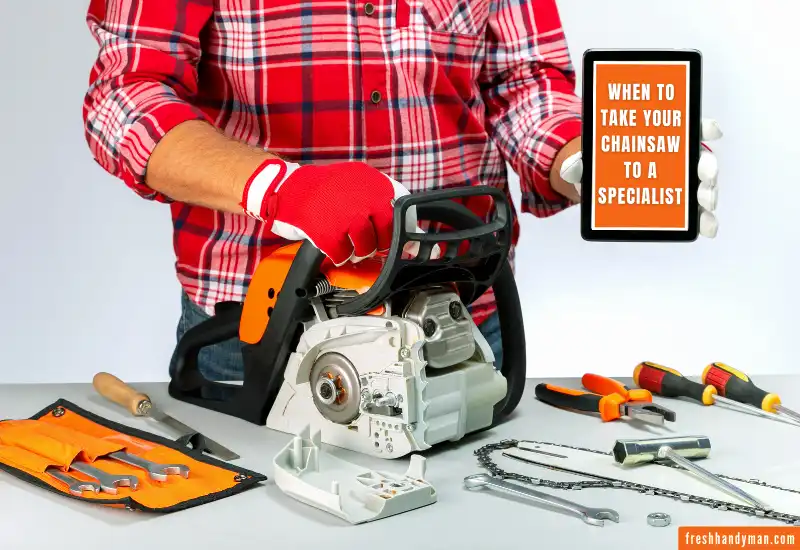
I like to think of myself as a guy who does things on his own. And if you ask me, most of the issues that you’ll face with a chainsaw can be fixed without taking it to the shop for repairs. Troubleshooting your chainsaw might seem intimidating at first, but once you know the signs and fixes, things become much easier.
But I’ll admit – there are some situations where it’s better to take your chainsaw to a specialist rather than experiment with different fixes. If you’ve tried the troubleshooting tips that I have talked about in this article and still you can’t get your chainsaw to fire up, then it’s best to take it to an expert for a professional repair.
The Bottom Line
Chainsaws act up, and if your job requires you to use a chainsaw, it’s important you learn how to take care of it. And that includes learning how to clean your chainsaw and do small maintenance like replacing the spark plug and resharpening the blade.
Now Stihl is an amazing brand, one of the best there is. But that doesn’t mean that their chainsaws are indestructible. If you expect your chainsaw to work perfectly all the time, then you’re not really being realistic. Starting problems in chainsaws is pretty common, and fixing these issues isn’t that complicated either.
I hope my article on Stihl chainsaw’s starting problems could help you understand how to overcome these issues and get your chainsaw back to its working conditions. Good luck!
